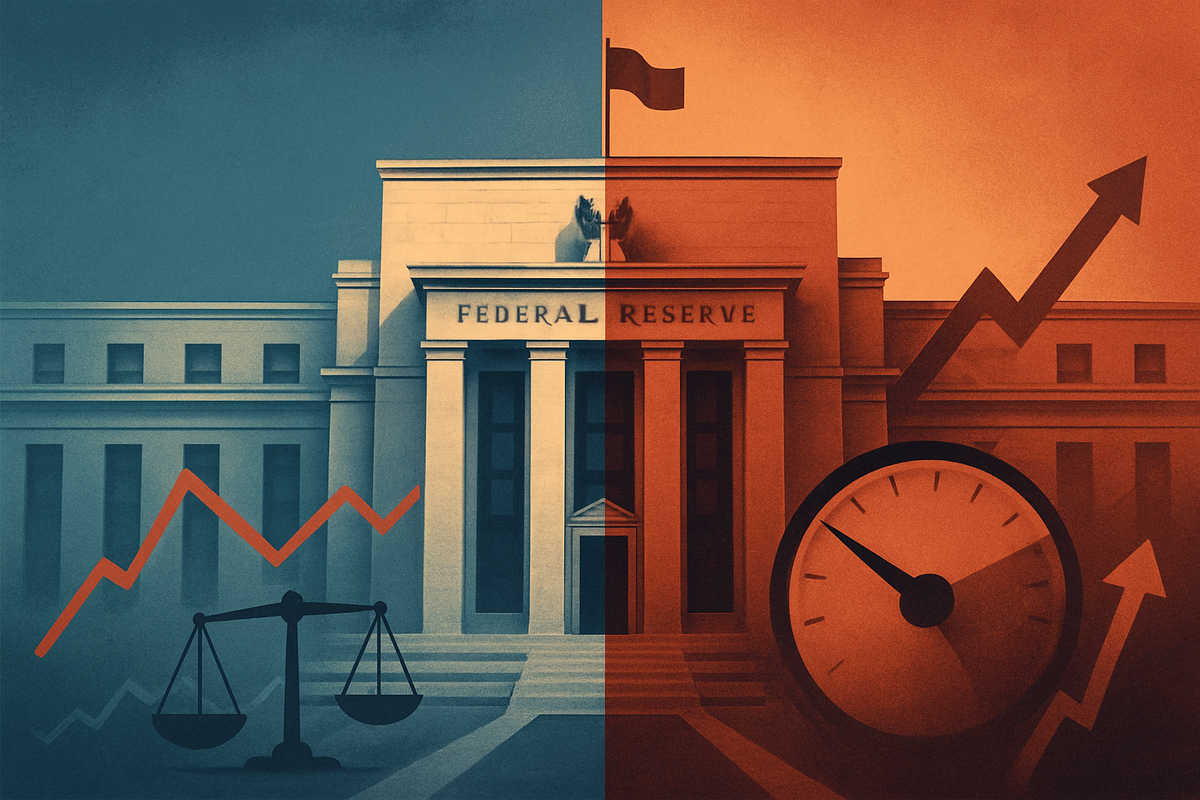
As November 2025 unfolds, the Federal Reserve finds itself at a critical juncture, marked by significant internal divisions over the current economic stance and the appropriate path for monetary policy. This divergence was starkly highlighted by the Federal Open Market Committee's (FOMC) recent decision to cut interest rates to the 3.75%-4.00% range, a move that passed with a notable 10-2 vote, signaling a clear lack of consensus among the central bank's policymakers. Fed Chair Jerome Powell has openly acknowledged these "strongly differing views," casting a shadow of uncertainty over future rate adjustments, especially as a government shutdown has severely impacted the availability of crucial economic data, forcing the Fed to navigate a complex landscape with incomplete information.
The core of the debate centers on the health of the labor market, the stubborn trajectory of inflation, and the overall restrictiveness of current monetary policy. While some officials advocate for further easing to support a softening job market and address a potentially lower "neutral rate" of interest, others remain steadfast in their commitment to bringing inflation down to the Fed's 2% target, fearing that premature rate cuts could reignite price pressures and undermine the central bank's credibility. This internal tug-of-war sets the stage for a period of heightened market volatility and intense scrutiny of every word from Fed officials, as the financial world attempts to decipher the future direction of U.S. monetary policy.
The Deepening Chasm: A Look Inside the FOMC's Deliberations
The recent FOMC meeting, which concluded with a rate cut to a range of 3.75%-4.00%, was far from a unanimous decision. The 10-2 vote underscores the profound philosophical and data-driven disagreements currently gripping the Federal Reserve. This marks the second rate cut this year, coming amidst a backdrop of mixed economic signals and a significant government shutdown that has left policymakers "flying blind," as described by Chair Powell, due to the interruption of official economic data flows.
Leading the charge for a more dovish stance is Governor Stephen Miran, who notably dissented for a larger 50-basis-point rate cut, arguing that the "neutral rate" of interest—the rate at which monetary policy is neither stimulative nor restrictive—may be considerably lower than previously assumed. Miran, along with others in the dovish camp like Fed Governor Christopher Waller, points to signs of softening in the labor market, including sluggish job growth and a gradual rise in the unemployment rate, as evidence that current policy is overly restrictive and risks pushing the economy into a deeper downturn. They suggest that factors such as tariffs and immigration changes have likely reduced America's long-term economic potential, meaning that current interest rates are effectively "slamming the brakes" harder than intended. Furthermore, the cooling of consumer price data, which showed inflation at 3.0% in September 2025—the slowest pace in over two years and just one percentage point above the Fed's 2% target—provides ammunition for those advocating for further easing.
On the hawkish side, officials like Kansas City Fed President Jeffrey Schmid, who dissented against the recent rate cut, express significant concern that inflation remains "too high" and that premature easing could jeopardize the Fed's hard-won progress. Dallas Fed President Lorie Logan and Cleveland Fed President Loretta Mester (and Beth Hammack) share this caution, stressing the need for clear and sustained evidence of inflation rapidly declining before supporting further cuts. They emphasize the importance of maintaining policy credibility and ensuring that inflation expectations remain anchored at 2%. Mester also believes the Fed is nearing neutral territory and needs to maintain a somewhat restrictive stance. Governor Lisa Cook echoed this sentiment, noting that the current policy rate remains "modestly restrictive," which she deems appropriate given that inflation is still above target. Some hawkish voices, including Schmid, also point to accommodative conditions in equity and credit markets as a sign that policy might not be as restrictive as needed to effectively curb inflation. The housing market, in particular, is noted as struggling, with some officials and Treasury Secretary Scott Bessent suggesting that sectors like housing are already in recession.
Corporate Fortunes Hang in the Balance: Winners and Losers from Fed Policy
The Federal Reserve's internal debate over interest rate policy carries significant implications for public companies across various sectors, creating potential winners and losers depending on which faction's views ultimately prevail. The trajectory of interest rates directly impacts borrowing costs, consumer spending, and investor sentiment, shaping the financial landscape for corporations.
If the dovish camp gains sway and the Fed embarks on a path of further, more aggressive rate cuts, companies highly sensitive to interest rates stand to benefit. The struggling housing sector, represented by builders like D.R. Horton (NYSE: DHI) and Lennar Corporation (NYSE: LEN), could see a much-needed boost as lower mortgage rates stimulate demand. Similarly, auto manufacturers such as General Motors (NYSE: GM) and Ford Motor Company (NYSE: F), along with other consumer discretionary companies like Amazon (NASDAQ: AMZN) and Target (NYSE: TGT), could experience increased sales as borrowing becomes cheaper and consumer confidence potentially rises. Companies with substantial debt loads, across all sectors, would also see their interest expenses decrease, improving their bottom lines. Growth stocks and technology giants, exemplified by Microsoft (NASDAQ: MSFT) and Apple (NASDAQ: AAPL), often thrive in lower-rate environments due to reduced discount rates applied to their future earnings, making their valuations more attractive. Small businesses, which often rely on variable-rate loans, would also find it easier to access and afford credit, potentially spurring investment and expansion.
Conversely, if the hawkish perspective maintains its grip, leading to a prolonged period of higher rates or a cautious approach to further cuts, certain sectors and companies could face headwinds. Banks, including major players like JPMorgan Chase (NYSE: JPM) and Bank of America (NYSE: BAC), could see their net interest margins squeezed if short-term rates fall more slowly than long-term rates, or if a restrictive policy dampens overall lending activity and economic growth. Companies with significant debt, particularly those with floating-rate loans, would continue to face higher interest expenses, impacting profitability. Utility companies and other dividend-paying stocks, often seen as bond proxies, might become less attractive to investors if bond yields remain competitive or rise further. Furthermore, any sustained economic slowdown resulting from a restrictive policy stance would broadly impact companies reliant on robust consumer spending and business investment. The ongoing uncertainty itself can also deter capital expenditure and hiring, affecting a wide range of industries.
Wider Significance: Navigating a Complex Economic Tapestry
The Federal Reserve's internal discord transcends mere policy adjustments; it reflects a deeper struggle to interpret an economy sending mixed signals and operates within a broader context of evolving industry trends, potential regulatory shifts, and historical precedents. This debate has significant ripple effects, not only domestically but also on global financial markets.
The current economic landscape is characterized by a softening labor market juxtaposed with persistent, albeit cooling, inflation. This "stagflation-lite" scenario—where growth slows while prices remain elevated—presents a formidable challenge for central bankers. The housing market, as noted by some officials and Treasury Secretary Scott Bessent, is already experiencing recessionary conditions, which could foreshadow broader economic weakness. This trend impacts not just construction and real estate firms, but also suppliers, lenders, and ancillary services. The debate over the "neutral rate" of interest is particularly significant; if the neutral rate is indeed lower than previously estimated, then current policy is far more restrictive than intended, potentially stifling economic potential in the long run. This re-evaluation could lead to a fundamental shift in the Fed's long-term monetary policy framework.
Regulatory and policy implications are also at play, exacerbated by the government shutdown that has interrupted the flow of official economic data. This "flying blind" scenario complicates the Fed's ability to make informed decisions, increasing the risk of policy errors. The lack of reliable, real-time data forces policymakers to rely more on anecdotal evidence, market indicators, and their own, often diverging, economic models. Historically, periods of significant Fed internal debate, especially concerning inflation and employment, have often preceded significant economic shifts or policy pivots. Comparisons can be drawn to the late 1970s and early 1980s, when the Fed grappled with high inflation, though the current situation lacks the same intensity. More recently, the post-2008 financial crisis era saw extensive debate over the efficacy of quantitative easing and the timing of interest rate normalization. The current divergence highlights the inherent difficulty in achieving consensus when economic data offers no clear path, and different officials prioritize different aspects of the Fed's dual mandate—maximum employment and price stability.
What Comes Next: Navigating the Path Ahead
The coming months are poised to be a period of intense observation and potential volatility as the Federal Reserve grapples with its internal divisions and the evolving economic landscape. The immediate focus will be on the December FOMC meeting, where the outcome of the interest rate decision remains highly uncertain.
In the short term, market participants will be keenly watching for any resolution to the government shutdown, as the resumption of official economic data releases is crucial for providing clarity. Without it, the Fed will continue to make decisions with incomplete information, increasing the likelihood of unexpected policy moves. Potential scenarios for the short term include: a pause in rate cuts as the Fed awaits more data and assesses the impact of previous cuts; another modest rate cut if dovish arguments gain traction and economic weakness persists; or, less likely but still possible, a more hawkish stance if inflation proves more stubborn than anticipated. Companies and investors will need to remain agile, ready to adapt to sudden shifts in monetary policy expectations.
Looking further ahead, the long-term possibilities are shaped by how the Fed ultimately resolves its internal debate and the underlying economic trends. If the dovish view on a lower neutral rate prevails, it could imply a future where interest rates remain structurally lower than historical averages, impacting everything from bond yields to corporate financing strategies. Conversely, if hawkish concerns about persistent inflation prove accurate, the economy could face a prolonged period of higher interest rates, potentially leading to slower growth. Market opportunities may emerge in sectors that benefit from either scenario – for instance, defensive stocks in a high-rate, slow-growth environment, or growth-oriented sectors if rates fall significantly. Challenges include increased market volatility, difficulty in forecasting earnings, and the need for companies to strategically pivot their capital allocation and debt management based on evolving rate expectations. Investors should prepare for continued uncertainty, emphasizing diversified portfolios and a focus on companies with strong fundamentals that can weather various economic conditions.
A Precarious Balance: Summarizing the Fed's Dilemma
The Federal Reserve stands at a critical crossroads, with its policymakers deeply divided on the appropriate course for monetary policy amidst a complex and often contradictory economic environment. The recent 10-2 vote to cut rates to 3.75%-4.00% underscores this internal struggle, pitting those concerned about a softening labor market and a potentially lower neutral rate against those steadfast in their commitment to taming persistent inflation. This debate is further complicated by a government shutdown, which has left the Fed "flying blind" due to a lack of crucial economic data.
Moving forward, the market should anticipate continued volatility and intense scrutiny of every statement from Fed officials. The immediate future hinges on the December FOMC meeting and any developments regarding the availability of economic data. The long-term implications are profound, potentially reshaping the Fed's approach to monetary policy and influencing the structural level of interest rates for years to come. Investors must remain vigilant, closely monitoring inflation reports (when available), labor market data, and the nuanced speeches of Fed governors and regional presidents. The ability of the Fed to navigate these diverging views and steer the economy towards its dual mandate of maximum employment and price stability will be the defining challenge of the coming months, with lasting impacts on corporate fortunes and the broader financial landscape.
This content is intended for informational purposes only and is not financial advice


















